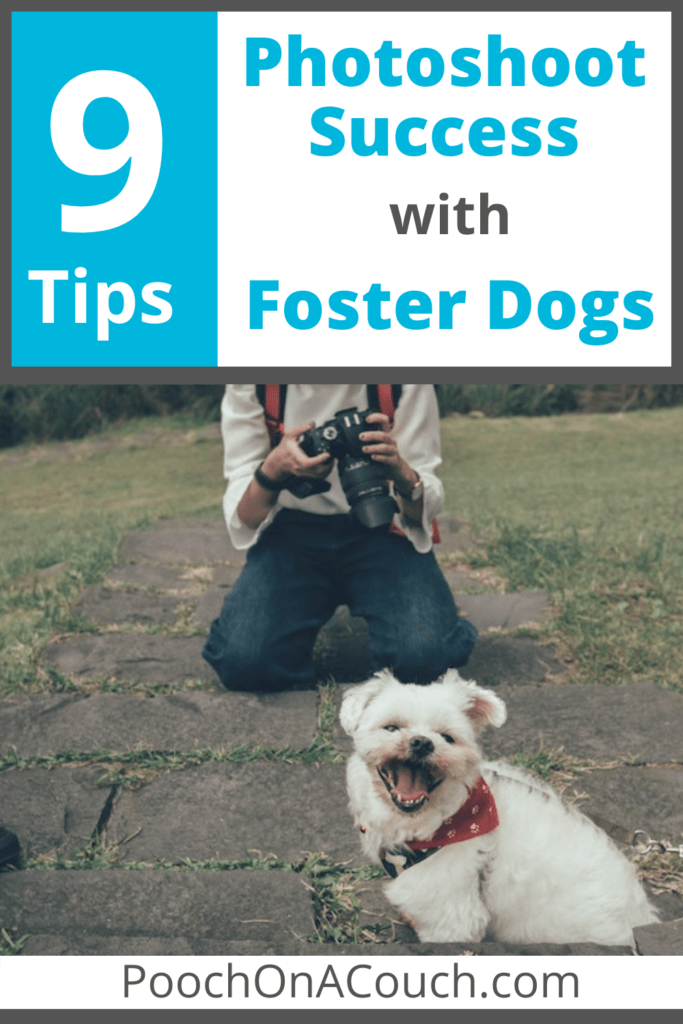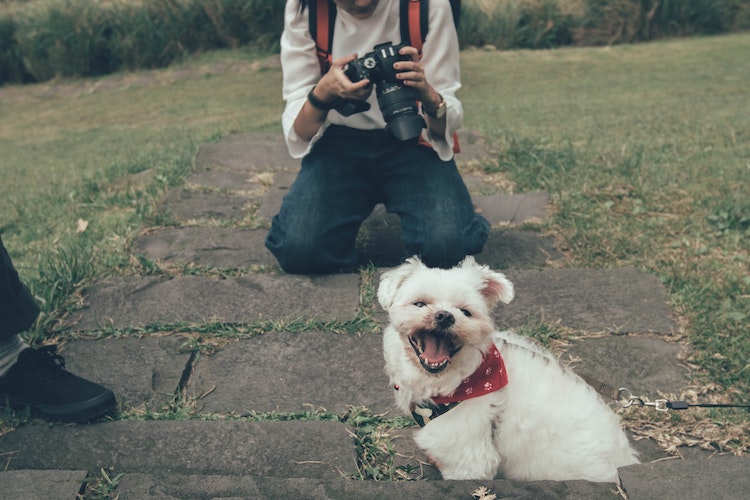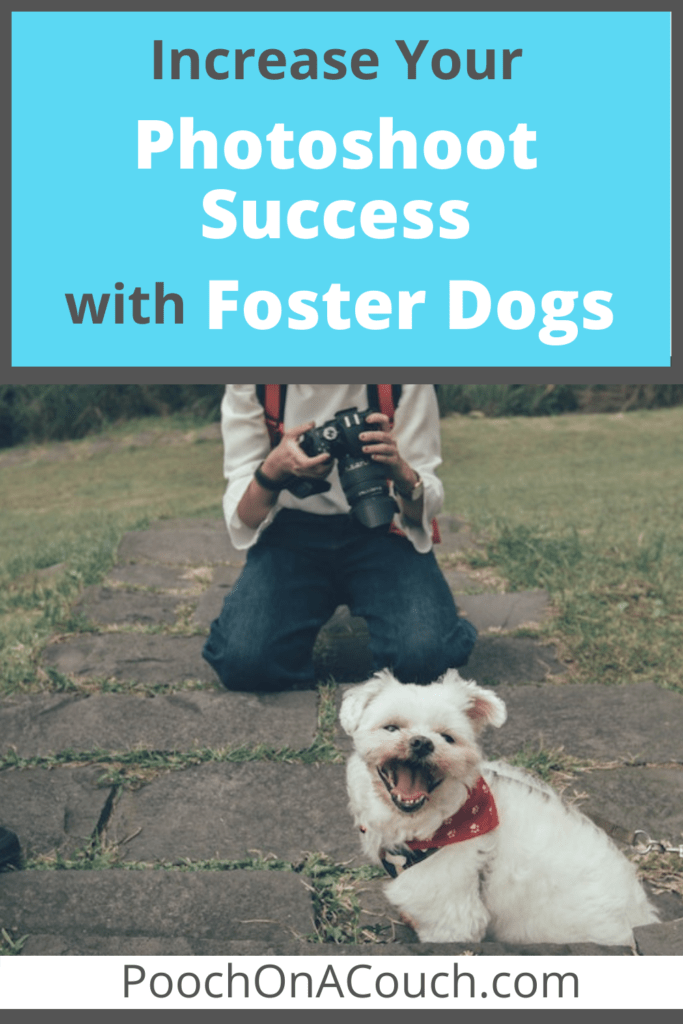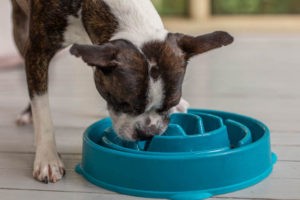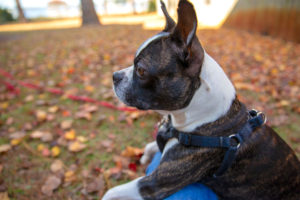Lawd-a-mercy, there’s pressure to get your foster dog healthy, happy, and posted for adoption on websites and all the social media sites. That means you are being asked to take some awesome photos that will pull at the heartstrings of families looking for a new pet.
And your foster dog is not cooperating.
Read on for some tips to help you gain photoshoot success with your dog.
Pet photography is unique in that it helps when both the photographer and the dog have some basic “dog photography for beginners” skills. It helps when your foster dog responds to sounds with interest, can look at you, and hopefully sit still for a nano-second.
Your Foster Dog May Be Afraid of Cameras
Dogs really don’t “hate” having their picture taken. It is simply too unfamiliar, too confusing, or it’s too boring.
Or, your foster dog has never ever seen or heard a camera before, much less seen one cover your face and point at them.
If your dog is afraid of cameras – like runs and hides or acts aggressive – STOP. Find a force-free trainer to help you help this dog overcome their fear of the camera. No photoshoot is worth giving your foster dog this level of stress.
Here are some tips to help you increase photoshoot success with your dog!
1. Prep your camera before you get started with the photoshoot.
Your foster dog has no idea why you are studying this contraption in your hand. Treat them like the celebrity they are and do the camera setting adjustments before you bring the dog to the session. Your focus should be on the dog and helping them give you the shot you want.
2. Choose your photoshoot space carefully.
Where are you going to set up your photo session with your foster dog? Your photoshoot success may depend on it!
Depending upon how long you’ve had your foster dog in your care, this dog may be more settled in a familiar place, not an idyllic setting somewhere in town. Familiar spaces are going to be more soothing to your foster dog than a new place. There may be some great street art in the city, but your foster dog doesn’t care about that, they’ll do better with the familiar.
Distractions should be at a minimum. Ideally, there should be few to no distractions for an optimal photoshoot experience. It’s not the time to combine a socialization outing and a photo op at the same time.
3. Carefully choose the time of day for the photoshoot with your dog.
My dogs are a little active late afternoon. Actually, they are quite active late afternoon because it is close to dinner time. While I can plan for some training experiences this time of day because my dogs are hungry and food motivated, it’s the wrong time to plan a photoshoot.
When is your foster dog more chill? Mid-morning? Afternoon? After a walk? These are the times you want to think about scheduling your photo-shoot with your foster dog. You want your dog to have that nice balance of energy release and focus on you and the fun activity you two are about to play.
4. Keep The photoshoot sessions short.
Take a few photos and then give your dog a break. Play a brief game or engage in some friendly pets. Then if your dog is still engaged with you, you can try and take more photos. Photoshoot success with your dog depends upon their engagement with you!
5. Decide what your expectations are for the dog, and keep your expectations fair.
Remember, you are photographing a foster dog. A dog that may be afraid of the camera or is still unsure of what is going on around them. You are not looking for a Wegman photo; you are looking for a photo of your foster dog that will attract interested adopters.
Keep expectations simple – one or two behaviors at a time.
6. Use yummy treats
You are asking your foster dog to do some “work” for you. You need to pay them for that work! Bring out the boiled chicken, dehydrated liver, or your secret dog treat recipe that your foster dogs just love. Treats need to be super-duper high value and you need lots of them in your pocket.
7. Learn The Basics Of Counter-Conditioning.
You may have a foster dog that is afraid of the camera or noises or the outdoors or the props. They may not be ready for a photoshoot. If you need help with ways to help your foster dog overcome their fear of cameras, read WHY IS MY FOSTER DOG AFRAID OF THE CAMERA?
For a great read on counter-conditioning with the camera, read here
*Note* counter-conditioning training is a bit technical. Dogs with moderate to severe fears would do best to be seen by a force-free trainer skilled in counter-conditioning training. The last thing you want is to inadvertently make this dog’s fears worse.
8. Consistency Is Key.
From your tone of voice to your use of equipment to your overall demeanor. Keep consistent. Photo shoots are not a natural experience for dogs. They have a level of stress attached. Changing the lighting or dragging in one prop after the other may cause a stress response in your foster dog.
Simple, simple plans with brief interludes will help your foster dog experience photo shoots as fun and not drudgery.
9. Patience, Patience, Patience
Do not be in a hurry to get the perfect photo. Don’t make big plans for getting several different shots. Have a simple plan for one shot and stay patient. Stay engaged with the dog. Be prepared to abort.
If either you or the dog seems frustrated, stop. Take a break. Try again later.
Debrief Each Session to Increase photoshoot success with your dog the next time.
Do think about what might have triggered the frustration. Did you have too high expectations? Were you unprepared? Did you take the session too long?
Was your foster dog not feeling well? Still decompressing? Too distracted or energetic? Confused about what you were asking the dog to do?
Debrief the photoshoot event with yourself and make adjustments to your next photoshoot session. Not only will your foster dog become a model subject, but you’ll also have a lot more fun photographing your foster dogs.
